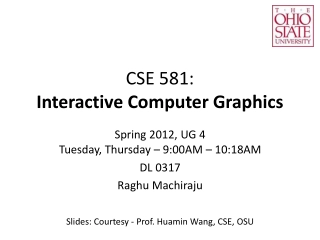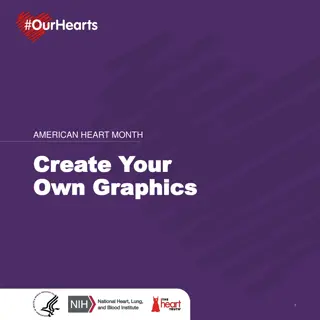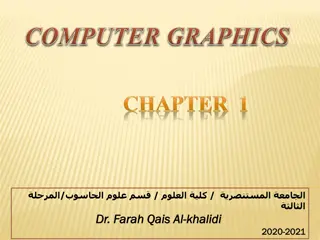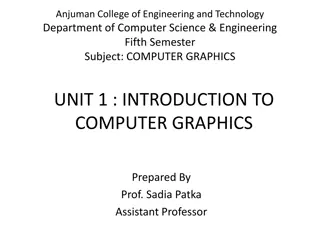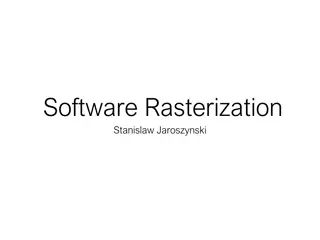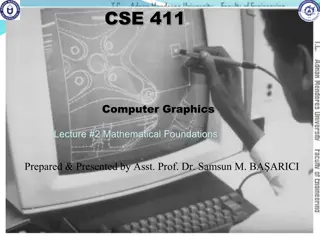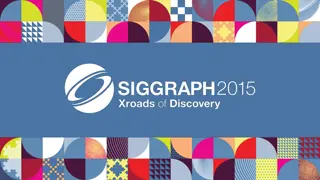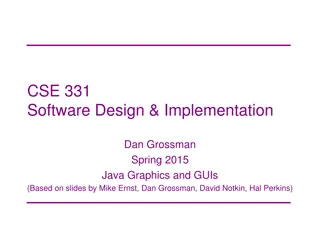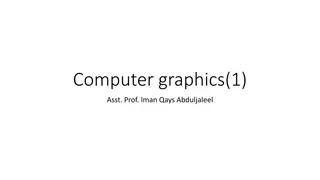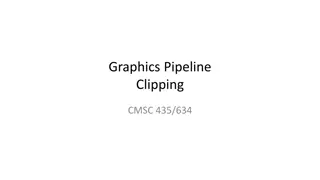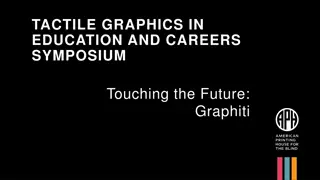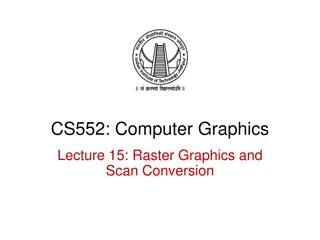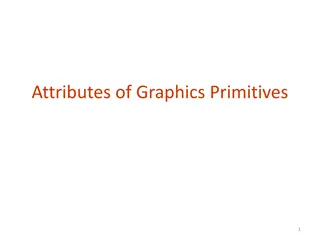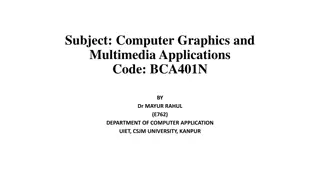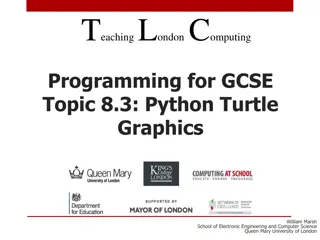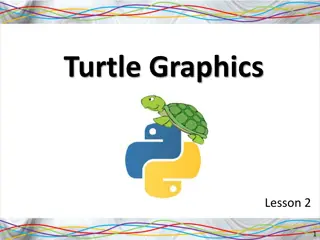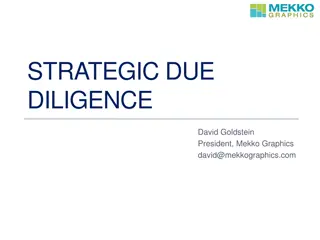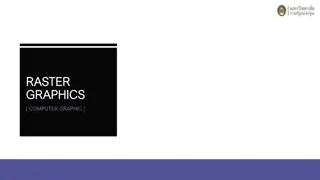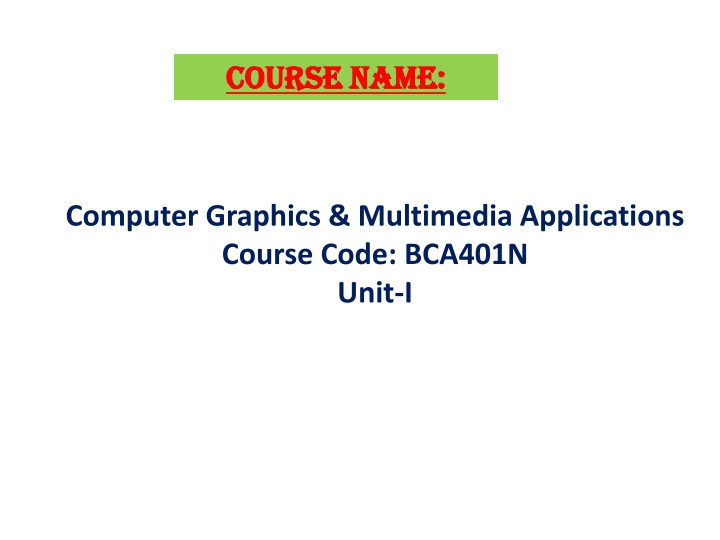
Computer Graphics and Multimedia Applications: An Overview
In this course, students will delve into the world of computer graphics and multimedia applications, learning about the creation, manipulation, and representation of images using software techniques. The course covers topics such as the introduction to computer graphics, definition, reasons behind its usage, and various applications in fields like education, training, and simulation. Through this course, students will gain a comprehensive understanding of how computer graphics play a vital role in modern technology and user interfaces.
Download Presentation

Please find below an Image/Link to download the presentation.
The content on the website is provided AS IS for your information and personal use only. It may not be sold, licensed, or shared on other websites without obtaining consent from the author. If you encounter any issues during the download, it is possible that the publisher has removed the file from their server.
You are allowed to download the files provided on this website for personal or commercial use, subject to the condition that they are used lawfully. All files are the property of their respective owners.
The content on the website is provided AS IS for your information and personal use only. It may not be sold, licensed, or shared on other websites without obtaining consent from the author.
E N D
Presentation Transcript
Course Name: Course Name: Computer Graphics & Multimedia Applications Course Code: BCA401N Unit-I
Introduction of Computer Graphics Introduction of Computer Graphics It is difficult to display an image of any size on the computer screen. This method is simplified by using Computer graphics. Graphics on the computer are produced by using various algorithms and techniques. Computer Graphics involves technology to access. The Process transforms and presents information in a visual form. The role of computer graphics is insensible. In today life, computer graphics has now become a common element in user interfaces, T.V. commercial motion pictures. Computer Graphics is the creation of pictures with the help of a computer. The end product of the computer graphics is a picture it may be a business graph, drawing, and engineering. In computer graphics, two or three- dimensional pictures can be created that are used for research. Many hardware devices algorithm has been developing for improving the speed of picture generation with the passes of time. It includes the creation storage of models and image of objects. These models for various fields like engineering, mathematical and so on. Today computer graphics is entirely different from the earlier one. It is not possible. It is an interactive user can control the structure of an object of various input devices.
Definition of Computer Graphics: It is the use of computers to create and manipulate pictures on a display device. It comprises of software techniques to create, store, modify, represents pictures.
Why computer graphics used? Suppose a shoe manufacturing company want to show the sale of shoes for five years. For this vast amount of information is to store. So a lot of time and memory will be needed. This method will be tough to understand by a common man. In this situation graphics is a better alternative. Graphics tools are charts and graphs. Using graphs, data can be represented in pictorial form. A picture can be understood easily just with a single look. Interactive computer graphics work using the concept of two-way communication between computer users. The computer will receive signals from the input device, and the picture is modified accordingly. Picture will be changed quickly when we apply command
Application of Computer Graphics 1. Education and Training: Computer-generated model of the physical, financial and economic system is often used as educational aids. Model of physical systems, physiological system, population trends or equipment can help trainees to understand the operation of the system. For some training applications, particular systems are designed. For example Flight Simulator. 2. Flight Simulator: It helps in giving training to the pilots of airplanes. These pilots spend much of their training not in a real aircraft but on the ground at the controls of a Flight Simulator. Advantages: 1. Fuel Saving 2. Safety 3. Ability to familiarize the training with a large number of the world's airports
2. Use in Biology: Molecular biologist can display a picture of molecules and gain insight into their structure with the help of computer graphics. 3. Computer-Generated Maps: Town planners and transportation engineers can use computer-generated maps which display data useful to them in their planning work. 4. Architect: Architect can explore an alternative solution to design problems at an interactive graphics terminal. In this way, they can test many more solutions that would not be possible without the computer. 5. Presentation Graphics: Example of presentation Graphics are bar charts, line graphs, pie charts and other displays showing relationships between multiple parameters. Presentation Graphics is commonly used to summarize
Financial Reports Statistical Reports Mathematical Reports Scientific Reports Economic Data for research reports Managerial Reports Consumer Information Bulletins And other types of reports
6. Computer Art: Computer Graphics are also used in the field of commercial arts. It is used to generate television and advertising commercial. 7. Entertainment: Computer Graphics are now commonly used in making motion pictures, music videos and television shows. 8. Visualization: It is used for visualization of scientists, engineers, medical personnel, business analysts for the study of a large amount of information. 9. Educational Software: Computer Graphics is used in the development of educational software for making computer-aided instruction 10. Printing Technology: Computer Graphics is used for printing technology and textile design.
Example of Computer Graphics Packages: 1. LOGO 2. COREL DRAW 3. AUTO CAD 4. 3D STUDIO 5. CORE 6. GKS (Graphics Kernel System) 7. PHIGS 8. CAM (Computer Graphics Metafile) 9. CGI (Computer Graphics Interface
Interactive and Passive Graphics (a) Non-Interactive or Passive Computer Graphics: In non-interactive computer graphics, the picture is produced on the monitor, and the user does not have any controlled over the image, i.e., the user cannot make any change in the rendered image. Non-interactive Graphics involves only one-way communication between the computer and the user, User can see the produced image, and he cannot make any change in the image. (b)Interactive Computer Graphics: In interactive Computer Graphics user have some controls over the picture, i.e., the user can make any change in the produced image. One example of it is the ping-pong game. Interactive Computer Graphics require two-way communication between the computer and the user. A User can see the image and make any change by sending his command with an input device
Advantages: 1. Higher Quality 2. More precise results or products 3. Greater Productivity 4. Lower analysis and design cost 5. Significantly enhances our ability to understand data and to perceive trends.

